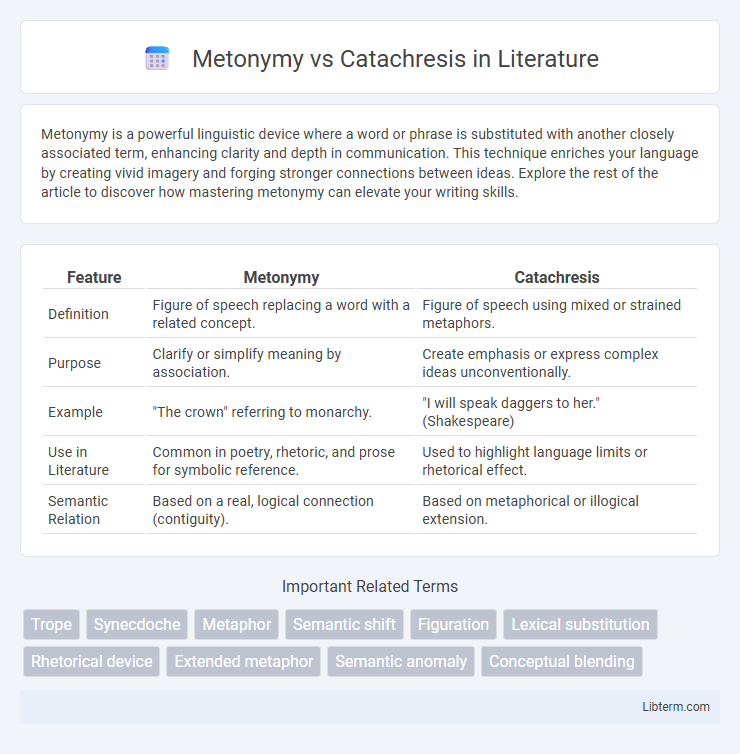Metonymy is a powerful linguistic device where a word or phrase is substituted with another closely associated term, enhancing clarity and depth in communication. This technique enriches your language by creating vivid imagery and forging stronger connections between ideas. Explore the rest of the article to discover how mastering metonymy can elevate your writing skills.
Table of Comparison
| Feature | Metonymy | Catachresis |
|---|---|---|
| Definition | Figure of speech replacing a word with a related concept. | Figure of speech using mixed or strained metaphors. |
| Purpose | Clarify or simplify meaning by association. | Create emphasis or express complex ideas unconventionally. |
| Example | "The crown" referring to monarchy. | "I will speak daggers to her." (Shakespeare) |
| Use in Literature | Common in poetry, rhetoric, and prose for symbolic reference. | Used to highlight language limits or rhetorical effect. |
| Semantic Relation | Based on a real, logical connection (contiguity). | Based on metaphorical or illogical extension. |
Understanding Metonymy: Definition and Examples
Metonymy is a figure of speech where a thing or concept is referred to by the name of something closely associated with it, such as "the crown" representing royalty. Common examples include using "the White House" to signify the U.S. president or administration, and "Hollywood" to denote the American film industry. This linguistic device enhances communication by relying on shared cultural knowledge and associative meaning rather than direct description.
Decoding Catachresis: What Does It Mean?
Catachresis involves the deliberate misuse or strained use of words, often creating a novel metaphor by extending language beyond its typical boundaries. Unlike metonymy, which substitutes a word with another closely related term, catachresis pushes semantic limits to convey complex or abstract ideas through unconventional expressions. Decoding catachresis reveals its function as a rhetorical device that challenges literal meaning, encouraging readers to interpret layered or figurative language in literature and speech.
Key Differences Between Metonymy and Catachresis
Metonymy involves substituting a word with another closely related term, such as using "the crown" to represent royalty, whereas catachresis occurs when a word is used in an unconventional or strained way, often creating a mixed metaphor, like "the chair's arm." Metonymy relies on established semantic relationships between terms, while catachresis intentionally breaks these conventional connections for rhetorical or stylistic effect. The key difference lies in metonymy's rootedness in logical association versus catachresis's use of metaphorical misuse.
Historical Roots of Metonymy and Catachresis
Metonymy traces its historical roots to ancient rhetoric, where it emerged as a figure of speech replacing the name of one thing with a closely related concept, often used by classical Greek and Roman orators to enhance persuasive language. Catachresis originated from the Greek word "katakhresis," meaning misuse or abuse, historically serving as a rhetorical device that intentionally applies a word in an unusual or metaphorically incorrect context to express complex ideas or emotions. Both metonymy and catachresis have evolved within literary and linguistic traditions, reflecting shifts in language use and creative expression from antiquity to modern times.
Metonymy in Everyday Language
Metonymy is a figure of speech where one word or phrase is replaced with another closely related term, such as "the crown" representing royal authority. In everyday language, metonymy simplifies communication by using familiar associations like "Hollywood" to denote the American film industry. This linguistic device enhances meaning through conceptual connections, making expressions more vivid and efficient.
Catachresis in Literary and Rhetorical Contexts
Catachresis in literary and rhetorical contexts refers to the intentional misuse or strained use of words to create vivid imagery or emphasize a concept that lacks a precise term. Unlike metonymy, which replaces a word with a closely related concept, catachresis often blends incompatible metaphors, producing striking or sometimes paradoxical effects in poetry and prose. Its strategic deployment enhances expressive depth by prompting readers to reconsider conventional language boundaries and amplifying thematic complexity.
Semantic Functions of Metonymy and Catachresis
Metonymy functions semantically by substituting a word with another closely related entity, such as using "the crown" to represent royalty, thereby creating a direct associative relationship that enhances meaning through contiguity. Catachresis involves the deliberate misuse or strained metaphor of a term in an unconventional way, often filling lexical gaps or expressing complex ideas that lack a precise term, thereby expanding semantic boundaries. While metonymy preserves logical and semantic relations through association, catachresis challenges and reshapes semantic norms by introducing novel or mixed references.
Common Confusions: Metonymy vs. Other Tropes
Metonymy often confuses readers because it replaces a concept with a closely related term, such as using "the crown" to refer to monarchy, but it differs from catachresis, which involves improper or strained metaphors like calling a leg of a table. Unlike metaphor, metonymy relies on a real-world association rather than resemblance, helping distinguish it from other tropes like synecdoche, which involves part-whole relationships. Many common misunderstandings arise when people conflate metonymy with metaphors or catachresis due to overlapping figurative language elements.
Impact of Catachresis on Meaning and Interpretation
Catachresis creates a deliberate misuse or strained use of words, which disrupts conventional meaning and invites readers to reinterpret language in innovative ways. This rhetorical device alters typical associations, forcing a re-examination of concepts and emphasizing metaphorical or symbolic significance beyond literal interpretation. The impact of catachresis on meaning deepens textual complexity and enriches interpretive possibilities by challenging standard linguistic expectations.
Practical Applications: Using Metonymy and Catachresis Effectively
Metonymy enhances communication by substituting related terms, such as using "the crown" to represent monarchy, allowing concise and vivid expression in marketing and political speeches. Catachresis, often leveraging exaggerated or mixed metaphors like "a sea of troubles," can create impactful imagery and emotional resonance in literary and rhetorical contexts. Effective use of metonymy and catachresis requires understanding their cognitive effects, ensuring clarity while enriching narrative depth and persuasive power.
Metonymy Infographic

 libterm.com
libterm.com